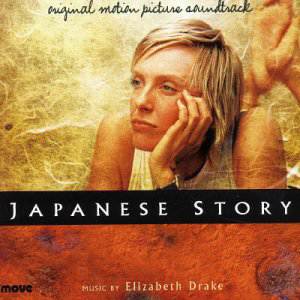Japanese Story
Music composed by Elizabeth Drake
Vocals – Shelley Scown
Koto & Shamisen – Satsuki Odamura
Guitar – John Phillips
Percussion – Peter Neville
Drums – Peter Jones
Orchestrations by Ricky Edwards
Available on Move Records / MOVE MD 3279
Running time: 58.30
Crotchet Amazon UK Amazon US

See also:
American Beauty
- S1m0ne
- Japanese Story page at Move Records (includes MP3 samples from the album)
Move Records introduces composer Elizabeth Drake's work with this attractive package of her soundtrack for Japanese Story, a release that comes with a ravishing 16 page booklet filled with background information on the movie's plot and production, an introduction and illustration of the music by the composer herself, along with her full bio and the score's complete credits. This enhanced cd version also contains two additional bonus tracks and movie trailer.
The Sue Brooks directed film recounts the story of Sandy, a geologist, and Hiromitsu, a Japanese businessman, who play out a story of human inconsequence in the face of the blistering universe. Set against the background of an Australian desert landscape with so much space but so few people, the end of the journey leaves no-one capable of going back to where they started. The score emanates from the relatively unknown composer Elizabeth Drake, who previously worked on For love or Money and Breathing Underwater among others.
The composer utilises the typical western strings, tonalities and harmonic composition, all combined with Japanese cultural elements; musical instruments, modes, folksongs and rituals, to help elevate the story. The listener is ushered in at once with the opening 'Chinsagu No Hana', one of the two Japanese traditional folksongs featured on this album. The song is edited and orchestrated by Drake. Its structure essentially works as the score's main theme, which is a playful and memorable 9-note motif performed on the shamishen, accompanied by 'warbling' western-type writing for the strings along with koto and percussion. At about the middle of the song, beautifully sung Japanese vocals appear.
Such folksongs from Okinawa are traditionally sung by three or more singers, a kind of folk choir, accompanied by a jamishen, a slightly larger snake-skin version of the shamishen, played by Satsuki Odamura for this recording. The singer here surprisingly is of western origin, named Shelley Scown who – as we learn from the booklet's contents - was already experienced with in eastern inflections and pronunciation and she had an instant affinity with the wto folksongs.
'Opening Titles' feature beautiful shakuhachi melodies with eerie electronic accompaniment (particularly, an instrument named as 'soundtrack') along with seductive soft drum. The dark and tense atmosphere is enhanced by natural sound effects, and by interweaving the sound of an instrument of Japanese culture, the shakuhachi, with an ancient aboriginal melody percussion additionally suggests cultural displacement. The composer here obviously wanted to suggest that we are all foreigners, trespassers on this aboriginal land.
'I hate Karaoke' shamelessly echoes Thomas Newman's American Beauty and Carter Burwell's Sim0ne's groovier pieces which featured xylophone, piano and light percussion. 'No more map' continues in the same manner, with upbeat xylophone playing, violin pizzicatos and piano.
A different mood is introduced at 'Who are you' with electric guitar performing sweet, moody but tedious melodies along with synthesized strings, and later on, piano. This is all abruptly deranged by awkward and loud natural sound effects.
'Very old Rock' is based on the second Okinawa folksong and beginning exactly like 'Who Are You', actually feels like an extension of that piece. The writing tries hard in a minimalistic way, but the overall result is boring. It gives the impression that something important is going to happen, but when something finally does occur it is an unengaging setting of the folksong's Japanese vocals accompanied by the shamishen.
Synthesized violin' plays a constant 4-note arpeggio motif as the building basis for the string accompaniment and later a flute and a cello melody follow in 'At the waterhole'. A piece that tries to build tension but its only success is the stressed feeling the listener gets at the end. Added to the drawbacks of this track, is the oddly synthesized sound of the solo instruments.
'In the mirror' is the worst piece of the score, displaying a sad cello melody that ends abruptly to little effect.
'Hiromitsu' is an alternative composed instead of 'At the waterhole'. A lengthy orchestral piece with some electronics layered into the soundscape, it sadly fails to provide anything of interest. It is rather monotonous and tedious, chiefly due to poor chord progressions.
The album concludes with 'Japanese Story' which was not used in the final score, clearly because its tone is too dark for the film and it feels completely out of place with the rest of the music.
Overall, this score doesn't work as an album due to an over-attachment to minimalism and the particular sound of Thomas Newman, failing also due to poor instrumentation, insufficient development of ideas, lack of interesting motifs, melodies and chord procession. There's nothing really striking to draw the listener's attention apart from the fascinating first traditional folksong ('Chinsagu No Hana') , the Opening Titles, and the excellent upbeat xylophone and piano pieces like 'I Hate Karaoke', 'Debris in a Desert' and 'No More Map'.
Demetris Christodoulides
3
Return to Index